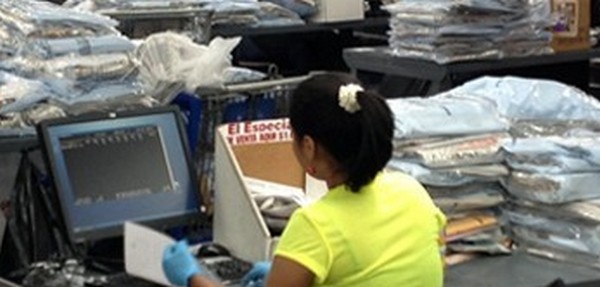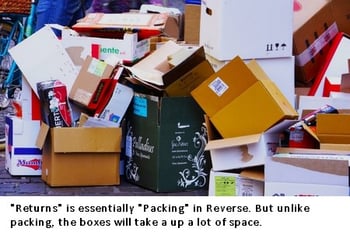
With the huge jump in facilities supporting Ecommerce from last year, the hiccups stemming from building the new capability in operations that were new to it are still ongoing. Individual vs. case shipping, single-item picking, and returns are some of the processes that have taken on a higher level of complexity and created difficult challenges for many facilities. Today we’ll spend a few minutes on one of the most visible, difficult and costly of those “new” processes – Returns.
Like Picking, there can be a lot of variables in your Returns Process based on your industry, but here is a basic checklist of things you need to be doing to give yourself the best foundation for building a successful Returns operation.
Start With Some Company Goals
Before getting into the specific steps, understand what your company’s objectives and goals should be for “Returns” in general. What is the target return rate? How does it compare with the industry? Do you expect to maximize the return of product to inventory for resale? What about getting rebates or chargebacks to manufacturers who don’t meet quality benchmarks? Most of what you need to plan ahead for in Returns is a corporate-wide exercise – marketing, product management, operations, and more.
The Pillars of An Efficient Returns Process
- Policy – What is your return policy? For Marketing and Sales purposes, “Unconditional Returns” is the preferred path to simplicity and customer loyalty. It also is a great technique for removing all perceived risk of trying your product for new prospects. But it also means a LOT more returns – potentially. Businesses with fewer conditions on Returns have found it also becomes a forcing function on raising quality because there is more at stake with each order that goes out – reputation AND profits.
On a less macro level, you’ll also want to have all the “operational” policy in place, mainly for how to make decisions about the returned product. What disqualifies product from being restocked? What training is required for workers to evaluate product accurately? And on a more customer-friendly side, do we include return shipping labels and/or pay for return shipping? - Dedicated Returns Space – You’ll want to have a dedicated space set up and equipped for efficient processing of returns. Some factors to include when designing your space:
- It should be near the docks, as the “intake” process will resemble Receiving in both the need for a bay and a putaway process.
- It will produce a LOT of waste from the packaging it arrives in, including many that did NOT come from your facility. Having large bins that can be quickly carted away and emptied will help keep working areas clear.

- If your space is too small for a dedicated space, and the volumes justify it, consider “sharing” space with another process that might be time-sensitive. i.e. Your returns will likely arrive in bunches by a specific time of day, so you can choose what slot in the day you want to process them. For example, if your orders are all picked and sorted for packing by mid-afternoon, packing stations can be flipped to serve as Return processing stations. Assuming the returns for the day are all in-house by that time, you can assign staff coming off of picking based on that day's numbers to assist with opening and sorting of Returns. Mobile Returns Stations could work too if the only space you have is something too far from Packing to make sense to double upon.
- If your space limitations lead you to think “none of the above” for your facility, then look at using a 3PL partner dedicated to Reverse Logistics. Some of them now also provide refurbishment and resell services, so the product never has to return to your facility.
- Labeling – One process element not always accounted for is that Returns can sometimes be the most label heavy process in your facility, especially if you are prioritizing recovering as much product as possible for resale. Labels to identify initial evaluation, others to mark a destination and another for replacing the product label and barcode that was on the original package from the manufacturer. Not all of these need to be printed, but you will want label printers
- Workstations – Being a core process in “Reverse Logistics”, Returns workstations will look a lot like a Packing station, something like a “Packing Deconstruction” station if you will, because it is essentially the Packing process in “Reverse”. RECEIVE package, OPEN package, CHECK if contents match the paperwork, INSPECT product and MOVE product back to inventory.
- Training – Training for Returns is unique in the warehouse. Depending on the products you are working with, staff may need anything ranging from “sniff” training (for clothing washed or laundered), to testing training (for basic electronics), etc. If you already have a Quality Control team that inspects merchandise coming in via Receiving from the manufacturer, then you already have a the core of a team that could do double duty in Returns.

- Peak Season – like most other warehouse processes, peak season will strain resources and fill your Returns team with the same adrenaline and stress as the other processes, but NOT at the same time. The big wave for returns starts crashing immediately after Christmas, so in one way it is easier to staff with extras you can move from other process areas. But the volumes also present opportunities for moving returned product back out to those who missed out on it earlier.
- Reporting – Your WMS or other system should be providing the data you need at the macro level like Return Rate (overall and by product), restock percentages, etc. but you’ll want to chart ground-level KPIs as well that track the team’s productivity.
It Gets A Little Better Every Day
If dealing with direct-to-consumer Returns was a difficult transition last year, then you have probably already started to see it improve in terms of your ability to handle the volumes and process them efficiently. And like other more familiar processes have done over time, it will continue to get better. Just remember you don’t have to reinvent the wheel – just accommodate the ones already out there to your business model and industry.
[Cover photo credit: National Distribution Alliance]










